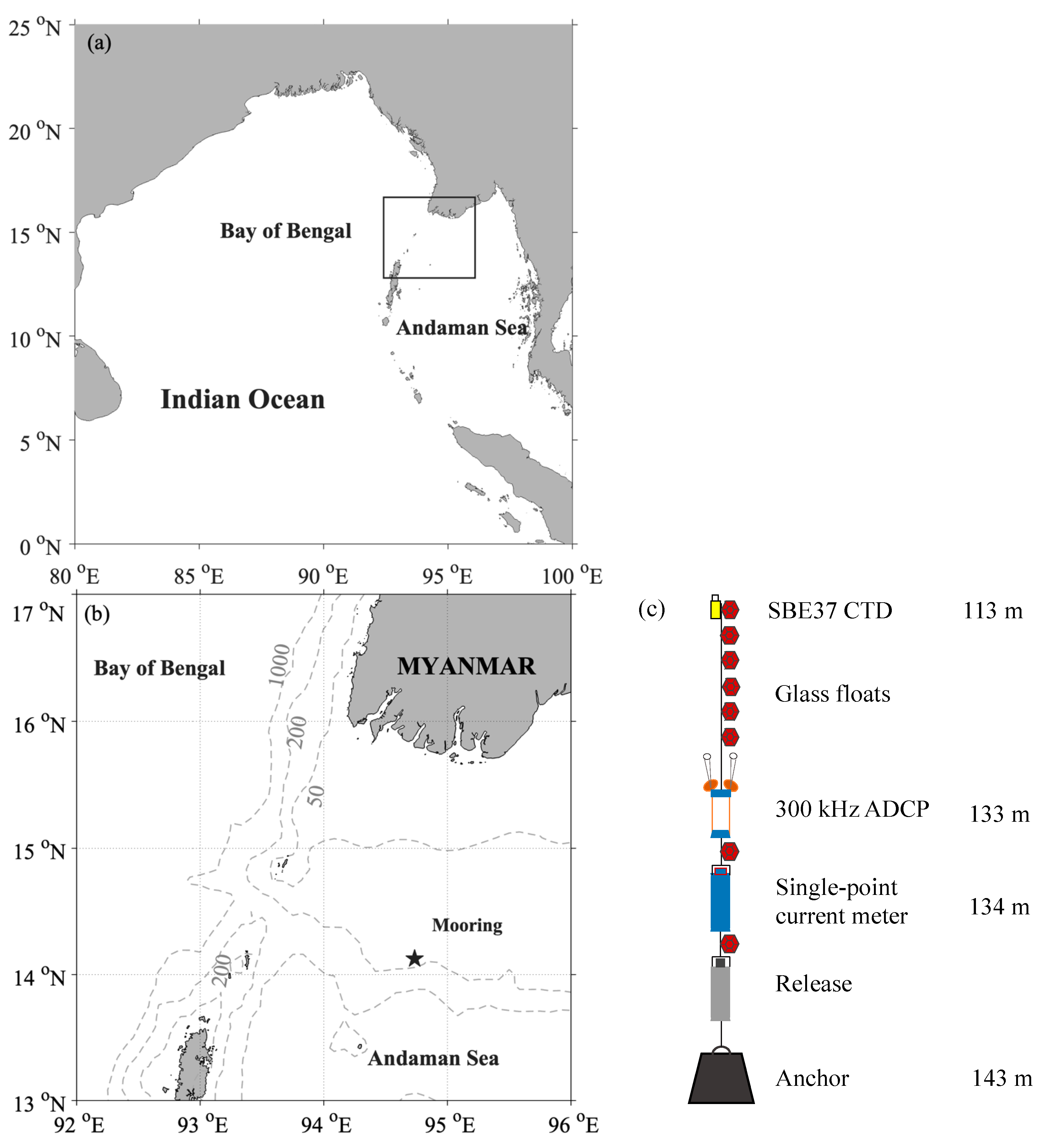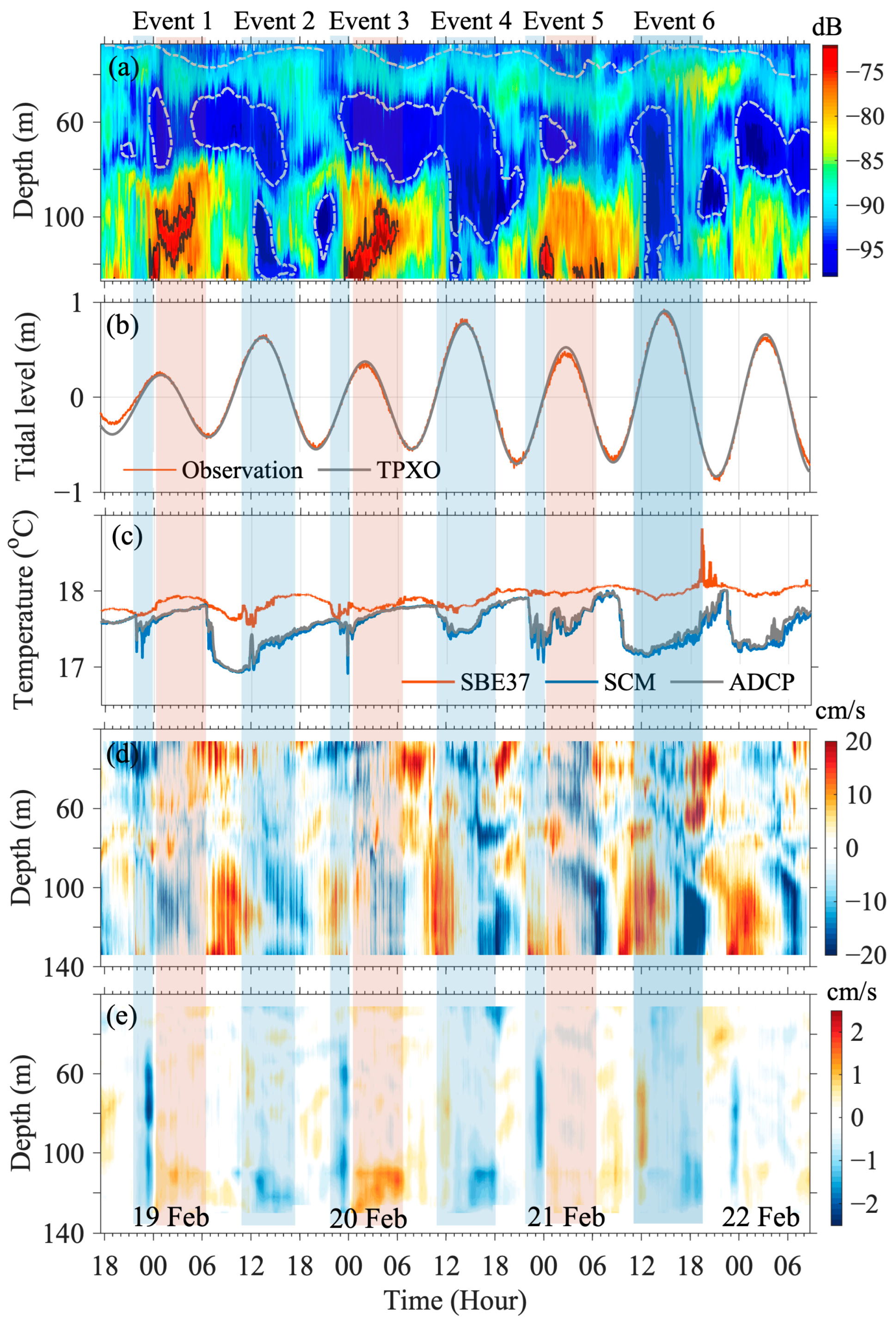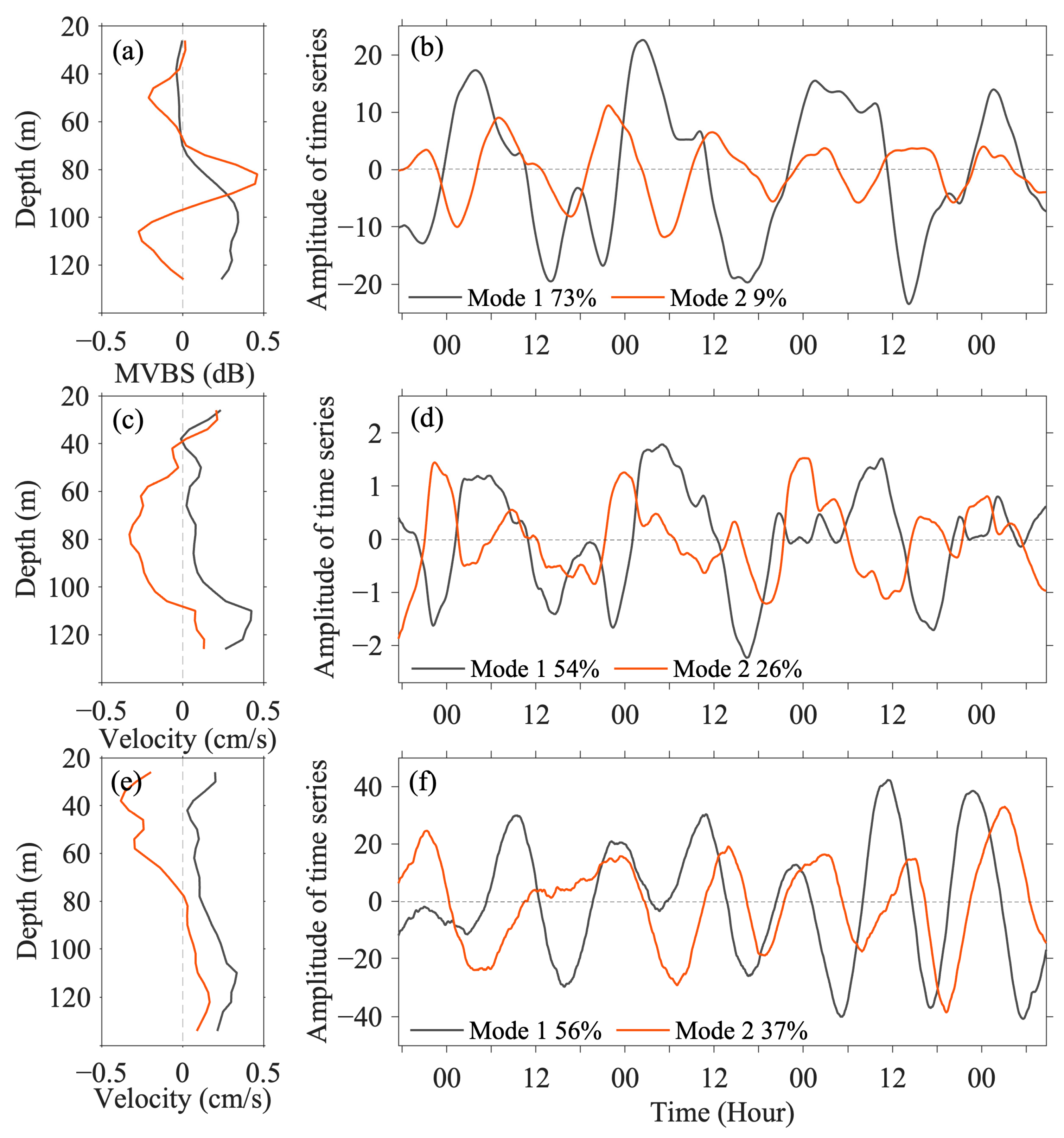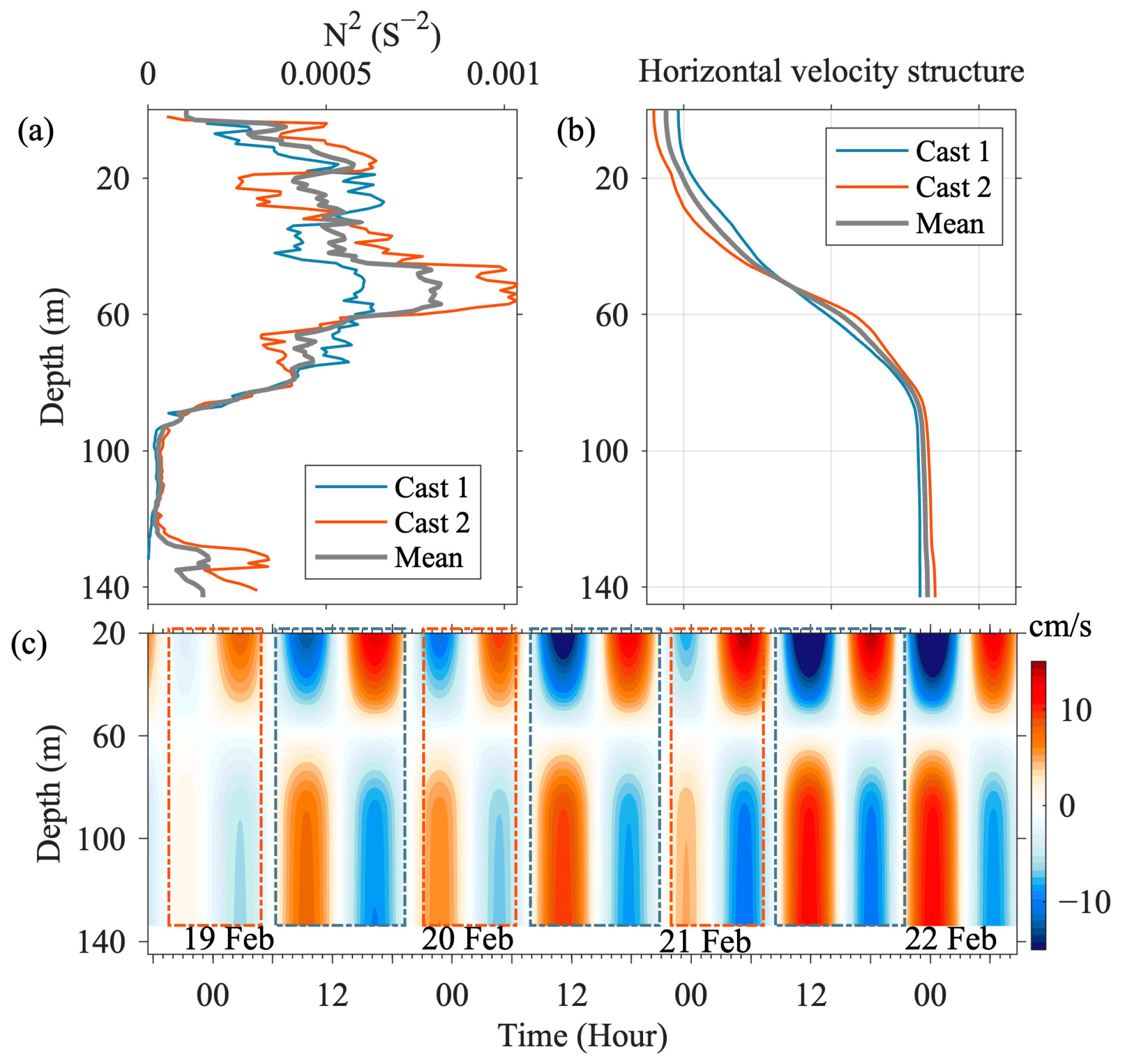A Preliminary Study of Suspended Matters Variation Associated with Hypoxia and Shoaling Internal Tides on the Continental Shelf of the Northern Andaman Sea
Abstract
:1. Introduction
2. Data and Methods
2.1. Data
2.2. Methods
3. Results
3.1. Variations of MVBS and Hydrological Condition
3.2. Modal Structure of MVBS and Currents in EOF and Semidriunal Internal Tides
3.3. Qualitatively Estimation of Suspended Matters Transport
4. Discussion
4.1. Suspended Matters in the Upper and Middle Layers
4.2. Suspended Matters in the Lower Layer
5. Conclusions
Author Contributions
Funding
Informed Consent Statement
Data Availability Statement
Acknowledgments
Conflicts of Interest
References
- Masunaga, E.; Homma, H.; Yamazaki, H.; Fringer, O.B.; Nagai, T.; Kitade, Y.; Okayasu, A. Mixing and sediment resuspension associated with internal bores in a shallow bay. Cont. Shelf Res. 2015, 110, 85–99. [Google Scholar]
- Tian, Z.; Jia, Y.; Chen, J.; Liu, J.P.; Zhang, S.; Ji, C.; Liu, X.; Shan, H.; Shi, X.; Tian, J. Bottom and intermediate nepheloid layer induced by shoaling internal solitary waves: Impacts of the angle of the wave group velocity vector and slope gradients. J. Geophys. Res. Oceans 2019, 124, 5686–5699. [Google Scholar]
- Yang, C.; Xu, D.; Chen, Z.; Wang, J.; Xu, M.; Yuan, Y. Diel vertical migration of zooplankton and micronekton on the northern slope of the South China Sea observed by a moored ADCP. Deep-Sea Res. Part II 2019, 167, 93–104. [Google Scholar]
- Liu, Y.; Guo, J.; Xue, Y.; Sangmanee, C.; Wang, H.; Zhao, C.; Khokiattiwong, S.; Yu, W. Seasonal variation in diel vertical migration of zooplankton and micronekton in the Andaman Sea observed by a moored ADCP. Deep-Sea Res. Part I 2022, 179, 103663. [Google Scholar]
- Oliveira, A.; Vitorino, J.; Rodrigues, A.; Jouanneau, J.M.; Dias, J.A.; Weber, O. Nepheloid layer dynamics in the northern Portuguese shelf. Prog Oceanogr. 2002, 52, 195–213. [Google Scholar]
- Inthorn, M.; Mohrholz, V.; Zabel, M. Nepheloid layer distribution in the Benguela upwelling area offshore Namibia. Deep-Sea Res. Part I 2006, 53, 1423–1438. [Google Scholar]
- Masunaga, E.; Arther, R.S.; Fringer, O.B.; Yamazaki, H. Sediment resuspension and the generation of intermediate nepheloid layers by shoaling internal bores. J. Mar. Syst. 2017, 170, 31–41. [Google Scholar]
- Bianchi, D.; Galbraith, E.D.; Carozza, D.A.; Mislan, K.A.S.; Stock, C.A. Intensification of open-ocean oxygen depletion by vertically migrating animals. Nat. Geosci. 2013, 6, 545–548. [Google Scholar]
- Jia, Y.; Tian, Z.; Shi, X.; Liu, J.P.; Chen, J.; Liu, X.; Ye, R.; Ren, Z.; Tian, J. Deep-sea Sediment Resuspension by Internal Solitary Waves in the Northern South China Sea. Sci. Rep. 2019, 9, 12137. [Google Scholar]
- Bruland, K.W.; Rue, E.L.; Smith, G.J. Iron and macronutrients in California coastal upwelling regimes: Implications for diatom blooms. Limnol. Oceanogr. 2001, 46, 1661–1674. [Google Scholar]
- Wang, Z.; DiMarco, S.F.; Ingle, S.; Belabbassi, L.; AI-Kharusi, L.H. Seasonal and annual variability of vertically migrating scattering layers in the northern Arabian Sea. Deep-Sea Res. Part I. 2014, 90, 152–165. [Google Scholar]
- Wang, H.; Chen, H.; Xue, L.; Liu, N.; Liu, Y. Zooplankton diel vertical migration and influence of upwelling on the biomass in the Chukchi Sea during summer. Acta Oceanol. Sin. 2015, 34, 68–74. [Google Scholar]
- Haney, J.F. Diel patterns of zooplankton behaviors. Bull. Mar. Sci. 1988, 43, 583–603. [Google Scholar]
- Cohen, J.H.; Forward, R.B. Spectral sensitivity of vertically migrating marine copepods. Biol. Bull. 2002, 203, 307–314. [Google Scholar] [PubMed]
- Wishner, K.F.; Outram, D.M.; Seibel, B.A.; Daly, K.L.; Williams, R.L. Zooplankton in the eastern tropical north Pacific: Boundary effects of oxygen minimum zone expansion. Deep-Sea Res. Part I 2014, 90, 152–165. [Google Scholar]
- Rabouille, C.; Conley, D.J.; Dai, M.H.; Cai, W.J.; Chen, C.T.A.; Lansard, B.; McKee, B. Comparison of hypoxia among four river-dominated ocean margins: The Changjiang (Yangtze), Mississippi, Pearl, and Rhone rivers. Cont. Shelf Res. 2008, 28, 1527–1537. [Google Scholar]
- Zhou, F.; Huang, D.; Ni, X.; Xuan, J.; Zhang, J.; Zhu, K. Hydrographic analysis on the multi-time scale variability of hypoxia adjacent to the Changjiang River Estuary. Acta Oceanol. Sin. 2010, 17, 4728–4740, (In Chinese with English Abstract). [Google Scholar]
- Cade, D.E.; Benoit-Bird, K.J. Depths, migration rates and environmental associations of acoustic scattering layers in the Gulf of California. Deep-Sea Res. Part I 2015, 102, 78–89. [Google Scholar]
- Hauss, H.; Christiansen, S.; Schütte, F.; Kiko, R.; Lima, M.E.; Rodrigues, E.; Karstensen, J.; Löscher, C.R.; Körtzinger, A.; Fiedler, B. Dead zone or oasis in the open ocean? Zooplankton distribution and migration in low-oxygen modewater eddies. Biogeosciences 2016, 13, 1977–1989. [Google Scholar]
- Garrett, C.; Kunze, E. Internal Tide Generation in the Deep Ocean. Annu. Rev. Fluid Mech. 2007, 39, 57–87. [Google Scholar]
- Ma, X.; Yan, J.; Hou, Y.; Lin, F.; Zheng, X. Footprints of obliquely incident internal solitary waves and internal tides near the shelf break in the northern South China Sea. J. Geophys. Res. Oceans 2016, 121, 8706–8719. [Google Scholar]
- Quaresma, L.S.; Vitorino, J.; Oliveira, A.; Silva, J. Evidence of sediment resuspension by nonlinear internal waves on the western Portuguese mid-shelf. Mar. Geol. 2007, 246, 123–143. [Google Scholar]
- Klymak, J.M.; Moum, J.N. Internal solitary waves of elevation advancing on a shoaling shelf. Geophys. Res. Lett. 2003, 30, 2045. [Google Scholar]
- Bogucki, D.; Dickey, T.; Redekopp, L.G. Sediment Resuspension and Mixing by Resonantly Generated Internal Solitary Waves. J. Phys. Oceanogr. 1997, 27, 1181–1196. [Google Scholar]
- Aghsaee, P.; Boegman, L. Experimental investigation of sediment resuspension beneath internal solitary waves of depression. J. Geophys. Res. Oceans 2015, 120, 3301–3314. [Google Scholar]
- Cacchione, D.; Wunsch, C. Experimental study of internal waves over a slope. J. Fluid Mech. 1974, 66, 223–239. [Google Scholar]
- Helfrich, K.R. Internal solitary wave breaking and run-up on a uniform slope. J. Fluid Mech. 1992, 243, 133–154. [Google Scholar]
- Cacchione, D.A.; Drake, D.E. Nepheloid layers and internal waves over continental shelves and slopes. Geo-Marine Lett. 1986, 6, 147–152. [Google Scholar]
- Lamb, K.G. Particle transport by nonbreaking, solitary internal waves. J. Geophys. Res. Oceans 1997, 102, 18641–18660. [Google Scholar]
- Ribbe, J.; Holloway, P.E. A model of suspended sediment transport by internal tides. Cont. Shelf Res. 2001, 21, 395–422. [Google Scholar]
- Sridevi, B.; Sarma, V.V. A revisit to the regulation of oxygen minimum zone in the Bay of Bengal. J. Earth Syst. Sci. 2020, 129, 107. [Google Scholar]
- Baronas, J.J.; Stevenson, E.I.; Hackney, C.R.; Darby, S.E.; Bickle, M.J.; Hilton, R.G.; Larkin, C.S.; Parsons, D.R.; Khaing, A.M.; Tipper, E.T. Integrating Suspended Sediment Flux in Large Alluvial River Channels: Application of a Synoptic Rouse-Based Model to the Irrawaddy and Salween Rivers. J. Geophys. Res. Earth Surf. 2020, 125, e2020JF005554. [Google Scholar]
- Osborne, A.; Burch, T. Internal solitions in the Andaman Sea. Science 1980, 208, 451–460. [Google Scholar]
- Alper, W.; Heng, W.C.; Lim, H. Observation of internal waves in the Andaman Sea by ERS SAR. In Proceedings of the IGARSS’97. 1997 IEEE International Geoscience and Remote Sensing Symposium Proceedings. Remote Sensing-A Scientific Vision for Sustainable Development, Singapore, 3–8 August 1997; pp. 1518–1520. [Google Scholar]
- Mohanty, S.; Rao, A.D.; Latha, G. Energetics of semidiurnal internal tides in the Andaman Sea. J. Geophys. Res. Oceans 2018, 123, 6224–6240. [Google Scholar]
- Magalhaes, J.M.; Da Silva, J.C.B. Internal Solitary Waves in the Andaman Sea: New Insights from SAR Imagery. Remote Sens. 2018, 10, 861. [Google Scholar]
- Jackson, C.; Silva, J.; Jeans, G. The generation of nonlinear internal waves. Oceanography. 2012, 25, 108–123. [Google Scholar]
- Cai, S.; Wu, Y.; Xu, J.; Chen, Z.; Xie, J.; He, Y. On the generation and propagation of internal solitary waves in the southern Andaman Sea: A numerical study. Sci. China Earth Sci. 2021, 64, 1674–1686. [Google Scholar]
- Yang, Y.; Huang, X.; Zhao, W.; Zhou, C.; Huang, S.; Zhang, Z.; Tian, J. Internal Solitary Waves in the Andaman Sea Revealed by Long-Term Mooring Observations. J. Phys. Oceanogr. 2021, 51, 3609–3627. [Google Scholar]
- Jithin, A.; Francis, P. Role of Internal Tide Mixing in Keeping the Deep Andaman Sea Warmer Than the Bay of Bengal. Sci. Rep. 2020, 10, 11982. [Google Scholar]
- Egbert, G.D.; Erofeeva, S.Y. Efficient inverse modeling of barotropic ocean tides. J. Atmos. Ocean. Technol. 2002, 19, 183–204. [Google Scholar]
- Deines, K.L. Backscatter estimation using broadband acoustic Doppler current profilers. In Proceedings of the IEEE Sixth Working Conference on Current Measurement, San Diego, CA, USA, 11–13 March 1999; pp. 249–253. [Google Scholar]
- Cao, A.; Guo, Z.; Pan, Y.; Song, J.; He, H.; Li, P. Near-Inertial Waves Induced by Typhoon Megi (2010) in the South China Sea. J. Mar. Sci. Eng. 2021, 9, 440. [Google Scholar]
- Kundu, P.K.; Beardsley, R.C. Evidence of a critical Richardson number in moored measurements during the upwelling season off northern California. J. Geophys. Res. 1991, 96, 4855–4868. [Google Scholar]
- Xu, J.; Xie, J.; Chen, Z.; Cai, S.; Long, X. Enhanced mixing induced by internal solitary waves in the South China Sea. Cont. Shelf Res. 2012, 49, 34–43. [Google Scholar]
- Lü, L.; Wang, X.; Wang, H.; Li, L.; Yang, G. The variations of zooplankton biomass and their migration associated with the Yellow Sea Warm Current. Cont. Shelf Res. 2013, 64, 10–19. [Google Scholar]
- Luo, J.; Ortner, P.B.; Forcucci, D.; Cummings, R.C. Diel vertical migration of zooplankton and mesopelagic fish in the Arabian Sea. Deep-Sea Res. Part II 2000, 47, 1451–1473. [Google Scholar]
- Goswami, S.C.; Rao, T.; Matondkar, S. Biochemical composition of zooplankton from the Andaman Sea. Indian J. Mar. Sci. 1981, 10, 296–300. [Google Scholar]
- Jitlang, I.; Pattarajinda, S.; Mishra, R. Composition, Abundance and Distribution of Zooplankton in the Bay of Bengal. Ecosyst. Based Fish. Manag. Bay Bengal 2008, 65–92. [Google Scholar]
- Seibel, B.A. Critical oxygen levels and metabolic suppression in oceanic oxygen minimum zones. J. Exp. Biol. 2011, 214, 326–336. [Google Scholar]
- Xu, A.; Chen, X. A Strong Internal Solitary Wave with Extreme Velocity Captured Northeast of Dong-Sha Atoll in the Northern South China Sea. J. Mar. Sci. Eng. 2021, 9, 1227. [Google Scholar]
- Dauhajre, D.P.; Molemaker, M.J.; Mcwilliams, J.C.; Hypolite, D. Effects of stratification on shoaling internal tidal bores. J. Phys. Oceanogr. 2021, 51, 3183–3202. [Google Scholar]
- McSweeney, J.M.; Lerczak, J.A.; Barth, J.A.; Becherer, J.; Colosi, J.A.; MacKinnon, J.A.; MacMahan, J.H.; Moum, J.N.; Pierce, S.D.; Waterhouse, A.F. Observations of shoaling nonlinear internal bores across the central California inner shelf. J. Phys. Oceanogr. 2020, 50, 111–132. [Google Scholar]
- Walter, R.K.; Woodson, C.B.; Leary, P.R.; Monismith, S.G. Connecting wind-driven upwelling and offshore stratification to nearshore internal bores and oxygen variability. J. Geophys. Res. Oceans 2014, 119, 3517–3534. [Google Scholar]
- Colosi, J.; Kumar, N.; Suanda, S.; Freismuth, T.; MacMahan, J. Statistics of internal tide bores and internal solitary waves observed on the inner continental shelf off of Point Sal, California. J. Phys. Oceanogr. 2018, 48, 123–143. [Google Scholar]







| Mooring | Location 94.74° E, 14.12° N | Deployment Time 18–22 February (UTC) |
|---|---|---|
| Instrument | Sampling information | Variable |
| SBE 37 | 1 min at 113 m | Temperature, salinity, and pressure |
| 300 kHz ADCP | 3 min (27 × 4 m bins) upward-looking at 133 m | Current and temperature |
| Single-point current meter | 3 min at 134 m | Current, temperature, and pressure |
| CTD | Deployment Time | Variable |
| Cast 1 Cast 2 | 16:35 18 February (UTC) 10:08 22 February (UTC) | Temperature, salinity, dissolved oxygen, and turbidity |
Disclaimer/Publisher’s Note: The statements, opinions and data contained in all publications are solely those of the individual author(s) and contributor(s) and not of MDPI and/or the editor(s). MDPI and/or the editor(s) disclaim responsibility for any injury to people or property resulting from any ideas, methods, instructions or products referred to in the content. |
© 2023 by the authors. Licensee MDPI, Basel, Switzerland. This article is an open access article distributed under the terms and conditions of the Creative Commons Attribution (CC BY) license (https://creativecommons.org/licenses/by/4.0/).
Share and Cite
Lin, F.; Liang, C.; Ding, T.; Zeng, D.; Zhou, F.; Ma, X.; Yang, C.; Li, H.; Zhou, B.; Liu, C.; et al. A Preliminary Study of Suspended Matters Variation Associated with Hypoxia and Shoaling Internal Tides on the Continental Shelf of the Northern Andaman Sea. J. Mar. Sci. Eng. 2023, 11, 1950. https://doi.org/10.3390/jmse11101950
Lin F, Liang C, Ding T, Zeng D, Zhou F, Ma X, Yang C, Li H, Zhou B, Liu C, et al. A Preliminary Study of Suspended Matters Variation Associated with Hypoxia and Shoaling Internal Tides on the Continental Shelf of the Northern Andaman Sea. Journal of Marine Science and Engineering. 2023; 11(10):1950. https://doi.org/10.3390/jmse11101950
Chicago/Turabian StyleLin, Feilong, Chujin Liang, Tao Ding, Dingyong Zeng, Feng Zhou, Xiao Ma, Chenghao Yang, Hongliang Li, Beifeng Zhou, Chenggang Liu, and et al. 2023. "A Preliminary Study of Suspended Matters Variation Associated with Hypoxia and Shoaling Internal Tides on the Continental Shelf of the Northern Andaman Sea" Journal of Marine Science and Engineering 11, no. 10: 1950. https://doi.org/10.3390/jmse11101950
APA StyleLin, F., Liang, C., Ding, T., Zeng, D., Zhou, F., Ma, X., Yang, C., Li, H., Zhou, B., Liu, C., & Jin, W. (2023). A Preliminary Study of Suspended Matters Variation Associated with Hypoxia and Shoaling Internal Tides on the Continental Shelf of the Northern Andaman Sea. Journal of Marine Science and Engineering, 11(10), 1950. https://doi.org/10.3390/jmse11101950







